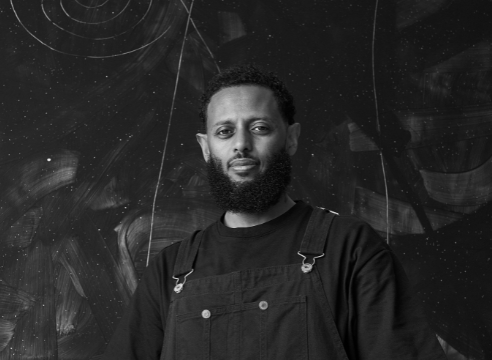
Southampton African American Museum is the perfect container for Making Space: One of These Black Boys a solo exhibition by the visionary Ethiopian-American artist Tariku Shiferaw—who is exhibiting for the first time at the historic barbershop turned museum. Born in Addis Ababa, Ethiopia, raised in Los Angeles, CA, and currently based in New York, Shiferaw’s experience of cultures informs his multifaceted reference points in his work as an abstract artist. Shiferaw invites us on a journey through the realm of mark-making and its profound significance within society and art history.
Making Space: One of These Black Boys challenges us to question the prevailing notion of who possesses the authority to make marks and shape narratives. Shiferaw’s deliberate gestures serve as a powerful counter to the systemic erasure that has long plagued our history. In this series, the artist not only engages with the recorded history of painting but also prompts us to deeply consider the nature of our society and its functioning, in both the physical and metaphysical.
One of These Black Boys was started in 2016 when Shiferaw was in his studio thinking, “How does one mark themselves into society after all that has taken place in history, in the past. Especially—how does a Black man, like myself, even engage in the conversation of painting or even think about having a place in that history?”
Growing up seeing graffiti tags all around Los Angeles, not necessarily knowing their meaning as an Ethiopian immigrant, Shiferaw noticed mark making all around him—and also how the graffiti would be crossed out by rival gangs, or painted over or covered up by the city, deeming these expressive marks as illegal. This phenomenon was even more present when he moved to New York as an adult, where the pavement was abundant with marks from the community. Shipping pallets were also an important part of his nuanced understanding of the world around him. The sheer amount of pallets strewn about the city were a sign of global trade and commerce. Shiferaw hones in on their recognizable shape, color, and architectural quality which are overlooked due to them being something to go around or to be moved out of the way. Drawing parallels to the trade, commodification and erasure of Black bodies and Black thought throughout history, these reference points are represented by the barred symbols in his works.
Inspired by the enigmatic forms of redacted information found in public FBI documents, Shiferaw places horizontal bars on top of his compositions, blurring the boundaries between erasure and creation; tradition and innovation. Painterly gestures encounter stark rectilinear shapes, creating a dynamic visual dialogue. Shiferaw shows this intentionality through repetition, which plays back to his initial interest in the redundant horizontal bars seen all over the city via these wooden shipping pallets.
The physical mediums in the series are carefully chosen materials. Shiferaw primarily utilizes acrylic paint and plastic. Plastic becomes a potent metaphor, representing the intricate interplay of identities within our society. By employing clear and black variants from different stages of his artistic practice, these materials symbolize the diverse range of bodies, subtly contracting and shriveling in response to their environment.
Shiferaw’s aesthetic fascination with color lies in the marriage of black and blue. This fascination emerged while listening to Louis Armstrong’s transcendent Jazz piece, “Black and Blue,” which ignited a profound reflection for him on the political connotations of color. Society often associates Black with negative traits such as darkness or the unknown, and blue with melancholy or formal societal structures. The blue uniform, symbolizing the system, starkly contrasts with the black body, representing an individual who exists outside the established structures. Shiferaw courageously challenges these preconceptions, employing Payne’s gray blue that when concentrated makes black, while also touching on the blues caused by the bruising of Black skin. This visual conversation invites us to find a sense of peace within these hues and unveils the poetic relationship between color and the structures that underpin our world.
Making Space: One of These Black Boys serves as a celebration of the kaleidoscope of Blackness. Through the carefully crafted titles, Shiferaw forms a symphony that resonates across the African diaspora, acknowledging that Blackness is not a monolithic entity but rather encompasses a rich tapestry of experiences, spanning continents and cultures. This series embraces the intricate complexities of these diverse identities, highlighting the multitude of individuals who leave their marks both as individuals and as a collective through visual, sensorial and coded language. Shiferaw draws inspiration from the music industry’s fascination with Black entertainers who innovated how the world listens to music. Each title is a song from genres across the African diaspora such as Hip Hop, R&B, Jazz, Blues, Reggae, and Afrobeats. This inclusion of music as a form of mark-making raises profound questions about authorship as historically Black entertainers did not have the rights to their own creations. Every mark made, whether visual or through titles, carries a deep intentionality, serving as tangible evidence of the artist’s engagement with these multifaceted historical contexts.
Making Space stands as an audacious invitation to challenge power dynamics and reclaim narratives. Through Shiferaw’s deliberate mark-making gestures, marginalized voices are empowered, reminding us of the impact that each stroke carries. As viewers, we are compelled to question the erasure that has marred history and to celebrate the resilience of the human spirit.
Written by Storm Ascher, Curator